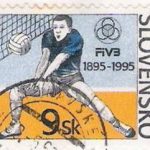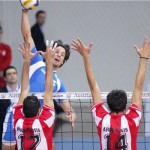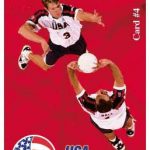 Volleyball recently celebrated it hundred year anniversary and is a game rich in history and tradition. As such the sport enjoys its own often fun vocabulary. This pages is dedicated to this fine tradition of using and improving the volleyball vocabulary. Make sure to leave your comments and additions in the comment section below!:)
Volleyball recently celebrated it hundred year anniversary and is a game rich in history and tradition. As such the sport enjoys its own often fun vocabulary. This pages is dedicated to this fine tradition of using and improving the volleyball vocabulary. Make sure to leave your comments and additions in the comment section below!:)
ACE – A serve that is not passable and results immediately in a point.
ANTENNA – The vertical rods (normally white and red) mounted near the edges of the net. The antennas are mounted directly above the sidelines and are not-in-play. Antennas are not usually used on outdoor nets.
APPROACH – Fast stride toward the net by a spiker before he jumps in the air. See Videos on Volleyball Spiking Approach here!
ASSIST – Passing or setting the ball to a teammate who attacks the ball for a kill. This stat is normally only logged for high school, college, and National/Olympic team play.
 ATTACK – The offensive action of hitting the ball. The attempt by one team to terminate the play by hitting the ball to the floor on the opponent’s side.
ATTACK – The offensive action of hitting the ball. The attempt by one team to terminate the play by hitting the ball to the floor on the opponent’s side.
ATTACK BLOCK – Receiving players’ aggressive attempt to block a spiked ball before it crosses the net.
ATTACK ERROR – An unsuccessful attack which does one of the following: 1) the ball lands out of bounds, 2) the ball goes into the net and terminates play or goes into the net on the third hit, 3)the ball is blocked by the opposition for a point or sideout, 4) the attacker is called for a center line violation, or 5) the attacker is called for illegal contact (lift, double hit…) on the attack.
ATTACKER – Also “hitter” or “spiker.” A player who attempts to hit a ball offensively with the purpose of terminating play in his or her team’s favor.
ATTACK LINE – A line 3m from the net that separates the front row players from the back row players. Commonly referred to as the “10-foot line.”
BACKCOURT – The area from the endline to the attack line.
 BACK SET – A set delivered behind the setter’s back, which is subsequently hit by an attacker.
BACK SET – A set delivered behind the setter’s back, which is subsequently hit by an attacker.
BACK ROW ATTACK – When a back row player attacks the ball by jumping from behind the 3m line before hitting the ball. If the back row player steps on or past the 3m line during take-off, the attack is illegal.
BEACH DIG – An open hand receive of the ball, also called a “Deep Dish”
 Bic – Low fast set out the back row. Lower pipe set. This set was first run indoor in college by Jeff Nygaard, Stein Metzger and John Speraw. Click on Bic to see instructions on how to run this effectively as well as hear the story of how Jeff and Stein came up with the name while playing at UCLA where they were the first to run the set in NCAA College Indoor.
Bic – Low fast set out the back row. Lower pipe set. This set was first run indoor in college by Jeff Nygaard, Stein Metzger and John Speraw. Click on Bic to see instructions on how to run this effectively as well as hear the story of how Jeff and Stein came up with the name while playing at UCLA where they were the first to run the set in NCAA College Indoor.
BLOCK – A defensive play by one or more players meant to deflect a spiked ball back to the hitter’s court. It may be a combination of one, two or three players jumping in front of the opposing spiker and contacting the spiked ball with the hands.
 BREWWWW – The call for the best South African Volleyball Player Ever! Well maybe the loudest South African Player Ever!
BREWWWW – The call for the best South African Volleyball Player Ever! Well maybe the loudest South African Player Ever!
BUMP – a common term for forearm passing. Gold Medalist Eric Fonoimoana on Bump Passing.
BALL HANDLING ERROR – Any time the official calls a double hit, a thrown ball or a lift (except on a serve reception or attack). For our purposes, this category also includes any blocking errors (when an official calls a blocker for a violation such as going into the net, centerline violation, reaching over the net, etc.).
BUMP PASS – The use of joined forearms to pass or set a ball in an underhand manner.
CAMPFIRE – A ball that falls to the floor in an area that’s surrounded by two, three, four or more players. At the instant after the ball hits the floor, it appears as if the players are encircling and staring at a campfire.
CENTER LINE – The boundary that runs directly under the net and divides the court into two equal halves.
CLOSING THE BLOCK – The responsibility of the assisting blocker(s) to join the primary blocker and create an impenetrable block in which a ball cannot fit between the two individual blockers.
CROSS COURT SHOT – An individual attack directed at an angle from one end of the offensive team’s side of the net to the opposite sideline of the defensive team’s court.
CUT SHOT – A spike from the hitter’s strong side that travels at a sharp angle across the net.
DECOY – An offensive play meant to disguise the spiker who will receive the set.
DEEP SET – Set to be hit away from the net to confuse or disrupt the timing of the blockers.
DIG – Passing a spiked or rapidly hit ball. Slang for the art of passing an attacked ball close to the floor.
DINK – A legal push of the ball around or over blockers.
DOUBLE BLOCK – Two players working in unison to deflect an attacked ball at the net back to the hitter’s side.
DOUBLE HIT – Successive hits or contacts by the same player. (Illegal)
DOUBLE QUICK – Two hitters approaching the setter for a quick inside hit.
DOUBLES – A game with two players on each side, most commonly played on a sand court.
DOWN BALL – A ball the blockers elect not to attempt to block because it has been set too far from the net or the hitter is not under control. A “Down Ball” is hit overhand and driven over the net with topspin while the player remains standing. “Down Ball,” is usually called aloud by the defense when it becomes apparent the attacker has no chance of hitting a powerful spike.
FIVE-ONE – A 6-player offensive system that uses five hitters and one setter.
FIVE SET – A back set to the right front hitter.
FLARE – Inside-out path of an outside spiker who hid behind a quick hitter.
FLAMING MOE – An alcoholic beverage consumed on the South African Pro beach volleyball tour. It is Black Sambuka which you put in your mouth and light on fire, this produces a blue flame much like the episode of the Simpsons.
FLOATER – A serve which does not spin or rotate and therefore moves in an erratic path. This is similar to a “knuckle ball” pitch in baseball.
FOREARM PASS – Join your arms from the elbows to the wrists and strike the ball with the fleshy part of your forearms in an underhand motion.
FOUL – A violation of the rules.
FOUR SET – A set 1′ from the sideline, and 1’ to 2′ above the net.
FOUR-TWO – A 6-player offensive system using four hitters and two setters.
FREE BALL – A ball that will be returned by a pass rather than a spike. This is usually called aloud by the defense instructing players to move into serve receive positions.
 Greatest Coach in NCAA Volleyball History – Al Scates
Greatest Coach in NCAA Volleyball History – Al Scates
Wrote the late Jim Murray, a Pulitzer Prize winning columnist for the Los Angeles Times, “Al Scates?! Precisely. The one and only. The man who is to volleyball what (John) Wooden was to basketball, (Red) Sanders was to football, Napoleon to artillery…”
HELD BALL – A ball that comes to rest during contact resulting in a foul.
HIT – To jump and strike the ball with an overhand, forceful shot.
HITTER – Also “spiker” or “attacker”
HITTING PERCENTAGE – kills vs. attempts
INSIDE SHOOT – A play set or a 33.
ISOLATION PLAY – Designed to isolate the attacker on a specific defender, normally to exploit a weakness or give a hitter a chance to hit against a single block.
JUNGLE BALL – Any volleyball game with people who don’t really know how to play volleyball. A common euphemism for this type of game is “Picnic Volleyball.”
JUMP SERVE – A serve that is started by the server tossing the ball into the air and jumping into and hitting the ball in its downward motion.
JOUST – When 2 opposing players are simultaneously attempting to play a ball above the net. Also see the Steino below!
Karch Kiraly – The greatest volleyball player in history.
KEY – To predict a team’s next play by observation of patterns or habits.
KILL – An attack that results in an immediate point or side out.
LINE – The marks that serve as boundaries of a court.
LINE SHOT – A ball spiked down an opponent’s sideline, closest to the hitter and outside the block.
LET SERVE – A serve that contacts the net. If the ball dribbles over, it’s playable just like any other ball that contacts the net on the way over. If the ball fails to clear the net, it will become dead when it either hits the serving team’s court, or is contacted by a player on the serving team.
MIDDLE-BACK – A defensive system that uses the middle back player to cover deep spikes.
MIDDLE-UP – A defensive system that uses the middle back player to cover dinks or short shots.
 MINTONETTE – The original name of the game of volleyball, created by William Morgan.
MINTONETTE – The original name of the game of volleyball, created by William Morgan.
MOSES – Serve in beach volleyball where you serve an ace down the middle and both players part like the red sea. Credit for this term goes to Seth Burnham
MULTIPLE OFFENSE – A system of play using different types of sets other than just normal outside sets.
Nail – Perfect pass in volleyball for the setter.
OFFSIDE BLOCK – Player at the net, which is on the side away from the opponent’s attack.
OFF-SPEED HIT – Any ball spiked with less than maximum force but with spin.
OUTSIDE HITTER – a left-front or right-front attacker normally taking an approach which starts from outside the court
OVERHAND PASS – A pass executed with both hands open, controlled by the fingers and thumbs, played just above the forehead.
OVERHAND SERVE – Serving the ball and striking it with the hand above the shoulder.
OVERLAP – refers to the positions of the players in the rotation prior to the contact of the ball when serving.
PANCAKE – A one-handed defensive technique where the hand is extended and the palm is slid along the floor as the player dives or extension rolls, and timed so that the ball bounces off the back of the hand.
PASS – see “Forearm Pass”
PENETRATION – The act of reaching across and breaking the plane of the net during blocking. “Penetration is the key to life!” – Al Scates (The greatest volleyball coach in NCAA College Volleyball history.)
Poacher – When you embarrass your opponent on the court and pick up his girlfriend on the sideline after.
POINT OF SERVICE – A serve that results in a point (an ace by NCAA standards) as the serve is not returnable due to a bad pass by the receiver, this number includes aces.
POWER ALLEY – A cross-court hit traveling away from the spiker to the farthest point of the court.
POWER TIP – A ball that is pushed or directed with force by an attacking team.
POWER VOLLEYBALL – A competitive style of volleyball started by the Japanese.
QUICK – a player approaching the setter for a quick inside hit
QUICK SET – a set (usually 2’ above the net) in which the hitter is approaching the setter, and may even be in the air, before the setter delivers the ball. This type of set requires precise timing between the setter and hitter.
READY POSITION – The flexed, yet comfortable, posture a player assumes before moving to contact the ball.
RECEPTION ERROR – A serve that a player should have been able to return, but results in an ace (and only in the case of an ace). If it is a “husband/wife” play (where the ball splits the two receivers), the receiving team is given the reception error instead of an individual.
RED CARD – a severe penalty in which an official displays a red card. The result of a red card may be a player is disqualified, the team loses the serve, or the team loses a point. A red card may be given with or without a prior yellow card as a warning; it is up to the official’s discretion.
ROLL – a certain way to pass a ball in which the digger, or passer lays out an arm, passes the ball, and rolls over the shoulder (over the shoulder roll) or back (barrel roll) after passing the ball. This is a quick way to return to action after the play.
ROOF – A ball that when spiked is blocked by a defensive player such that the ball deflects straight to the floor on the attacker’s side.
ROTATION – The clockwise movement of players around the court and through the serving position following a side out.
SERVE – One of the six basic skills; used to put the ball into play. It is the only skill controlled exclusively by one player.
SERVER – The player who puts the ball into play.
SERVICE ERROR – An unsuccessful serve in which one or more of the following occurs: 1) the ball hits the net or fails to clear the net, 2) the ball lands out of bounds, or 3) the server commits a foot fault.
SERVICE WINNER – A point the serving team scores when this player has served the ball. The point can be an immediate (in the case of an ace) or delayed (a kill or opponent attack error after a long rally). Therefore, the sum of the team’s service winners equals their score.
SET – The tactical skill in which a ball is directed to a point where a player can spike it into the opponent’s court.
SETTER – the player who has the 2nd of 3 contacts of the ball who “sets” the ball with an “Overhand Pass” for a teammate to hit. The setter normally runs the offense.
SIDE OUT – Occurs when the receiving team successfully puts the ball away against the serving team, or when the serving team commits an unforced error, and the receiving team thus gains the right to serve.
SIX PACK – Occurs when a blocker gets hit in the head or face by a spiked ball.
SIX-TWO – A 6-player offense using 2 setters opposite one another in the rotation. Setter 1 becomes a hitter upon rotating into the front row as setter 2 rotates into the back row and becomes the setter.
SOUP – The South African Version of the six pack where you get hit in the face by a spiked ball.
SPIKE – Also hit or attack. A ball contacted with force by a player on the offensive team who intends to terminate the ball on the opponent’s floor or off the opponent’s blocker.
 STEINO – Volleyball 3 finger pokey made famous by Stein Metzger.
STEINO – Volleyball 3 finger pokey made famous by Stein Metzger.
STRONG SIDE – When a right-handed hitter is hitting from the left-front position or when a left-handed hitter is hitting from the right-front position.
STUFF – A ball that is deflected back to the attacking team’s floor by the opponent’s blockers. A slang term for “block.”
TURNING IN – the act of an outside blocker turning his/her body into the court so as to ensure the blocked ball is deflected into the court and lands in-bounds.
UNDERHAND SERVE – a serve in which the ball is given a slight under-hand toss from about waist high and then struck with the opposite closed fist in an “underhand pitching” motion.
WEAK SIDE – When a right-handed player is hitting from right-front position or when a left-handed player is hitting from the left-front position.
WIPE – when a hitter pushes the ball off of the opposing block so it lands out of bounds
YELLOW CARD – a warning from an official indicated by the display of a yellow card. Any player or coach who receives two yellow cards in a match is disqualified. A single yellow card does not result in loss of point or serve.
Also don’t be afraid to add your own words in the comment section below. If it is good we will add it! Just think, in a 100 years from now you word could be used like: “Bic, Nail, Soup, Facial, Six-Pack, Steino, …”
